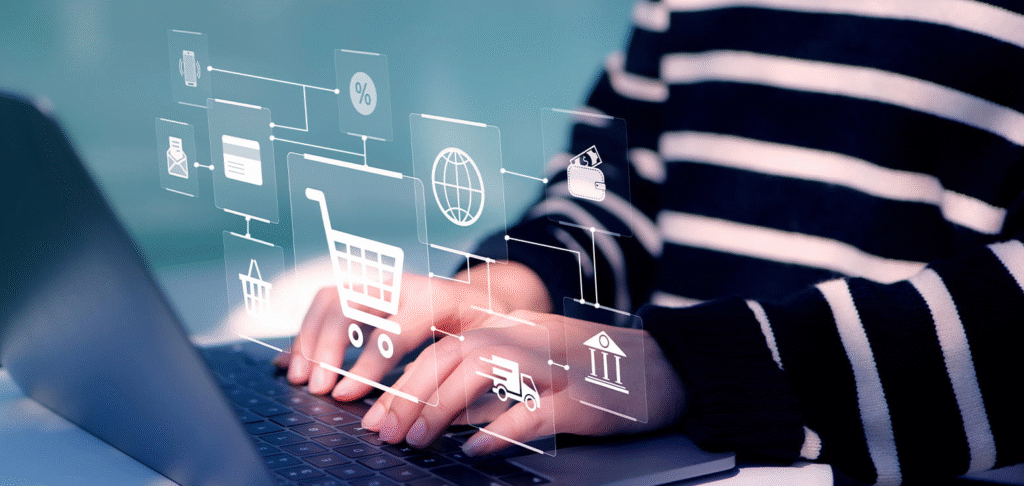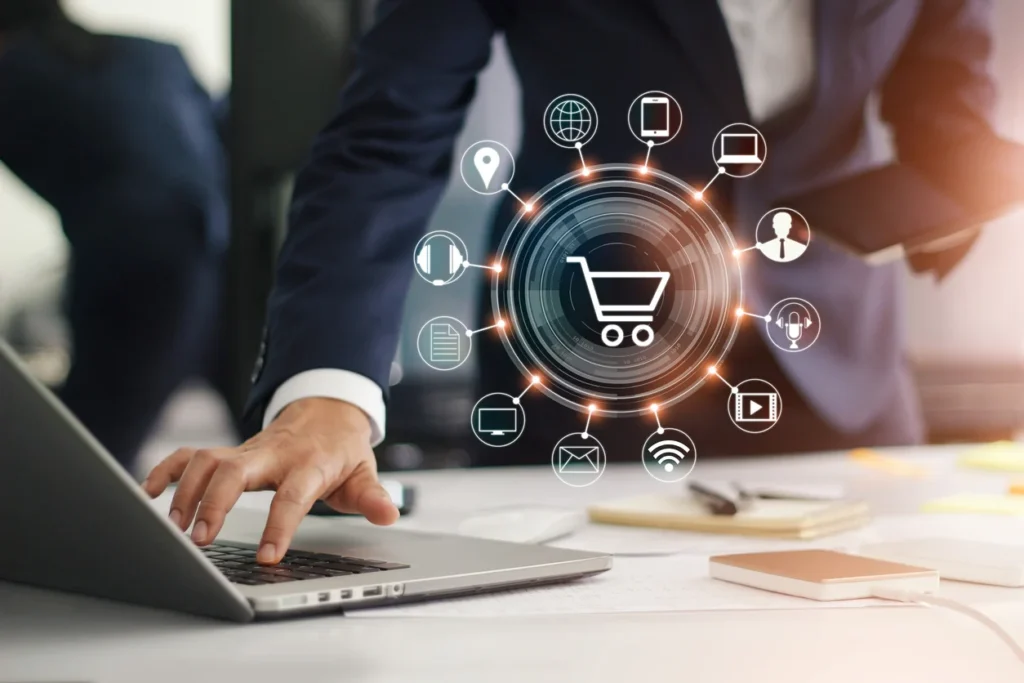Introduction
In the last two decades, ecommerce has revolutionized the way people buy and sell products worldwide. From ordering groceries to purchasing electronics or even booking services, ecommerce has become an integral part of modern life. But what exactly is ecommerce, and how does it work? This article explores the definition, mechanics, types, benefits, challenges, and future of ecommerce to provide you with a thorough understanding.
Key Takeaways
- Ecommerce is the buying and selling of goods and services via the internet.
- It operates through a complex ecosystem involving websites, payment gateways, logistics, and customer support.
- There are multiple ecommerce models, including B2C, B2B, C2C, and dropshipping.
- Benefits include convenience, wider reach, cost efficiency, and personalization.
- Challenges include cybersecurity, competition, logistics, and building customer trust.
- Ecommerce continues to evolve with technologies like AI, AR, and blockchain.
- Starting an ecommerce business requires careful planning, platform choice, and marketing strategies.
1. Defining Ecommerce
What Is Ecommerce?

Ecommerce, short for electronic commerce, refers to the buying and selling of goods and services over the internet. Unlike traditional commerce that happens in physical stores, ecommerce enables transactions through digital platforms, often accessible 24/7.
Ecommerce encompasses a wide range of online business activities, including:
- Online retail stores (e.g., Amazon, eBay)
- Online marketplaces (e.g., Etsy, Alibaba)
- Digital services (e.g., Netflix, Spotify)
- Online banking and bill payments
- Peer-to-peer sales via platforms like Facebook Marketplace
Key Characteristics of Ecommerce
- Digital transactions: All buying and selling happen electronically.
- Global reach: Customers and sellers from around the world can interact.
- Automation: Many aspects of the transaction process (ordering, payment, delivery) are automated.
- Convenience: Customers can shop anytime and anywhere using internet-enabled devices.
2. How Does Ecommerce Work?
To understand how ecommerce works, let’s break down the main components and processes involved in a typical ecommerce transaction.
The Ecommerce Ecosystem
- Customer Interaction
The process begins when a customer visits an ecommerce website or app. This could be a dedicated online store or a marketplace platform. - Product Search and Selection
Customers browse product categories, search for items, view product details, and read reviews. - Shopping Cart and Checkout
Customers add desired products to a virtual shopping cart. When ready, they proceed to checkout. - Payment Processing
At checkout, customers enter payment details. Ecommerce platforms integrate with payment gateways (e.g., PayPal, Stripe) to securely process payments. - Order Fulfillment
Once payment is successful, the seller processes the order—packing and shipping physical goods or delivering digital products/services. - Delivery and Customer Support
The order is delivered via logistics providers. Customers can track shipments and contact support if needed. - Post-Sale Activities
Includes feedback collection, returns or exchanges, and loyalty program engagement.
Technologies Behind Ecommerce
- Website or Mobile App: The user interface where customers interact.
- Payment Gateway: Securely authorizes and processes payments.
- Shopping Cart Software: Manages customer selections.
- Inventory Management Systems: Tracks stock levels and product availability.
- Customer Relationship Management (CRM): Manages customer data and communication.
- Logistics and Fulfillment Systems: Coordinates delivery and shipping.
3. Types of Ecommerce Models
Ecommerce isn’t a single, uniform business type; rather, it encompasses various models that serve different buyer-seller relationships and operational structures. Understanding these models helps entrepreneurs choose the right approach and strategy for their business. Let’s explore the main ecommerce models in detail:
1. Business-to-Consumer (B2C)
Overview:
B2C ecommerce involves businesses selling goods or services directly to individual consumers. It is the most common ecommerce model and represents the traditional retail experience but online.
Key Characteristics:
- Typically involves smaller transaction sizes compared to B2B.
- Emphasis on user experience, branding, and customer service.
- Marketing is often targeted toward emotional appeals and convenience.
Examples:
- Online retailers like Amazon, Walmart, and Zara.
- Service providers like Netflix or Spotify.
Advantages:
- Large potential customer base.
- Faster purchase decisions from consumers.
- Easier marketing through social media and influencer partnerships.
Challenges:
- High competition and price sensitivity.
- Need for excellent UX and customer support.
- Managing high volume of small orders.
2. Business-to-Business (B2B)
Overview:
In B2B ecommerce, companies sell products or services to other businesses. This model often involves bulk orders, longer sales cycles, and negotiated contracts.
Key Characteristics:
- Larger order quantities and higher transaction values.
- Focus on relationship-building and account management.
- Pricing can be customized per client.
Examples:
- Wholesale suppliers like Alibaba.
- SaaS companies providing software solutions to businesses.
Advantages:
- Higher revenue per sale.
- Long-term client relationships provide stability.
- Fewer but more predictable transactions.
Challenges:
- Longer sales cycles requiring nurturing and education.
- More complex purchasing processes.
- Integration with business procurement systems.
3. Consumer-to-Consumer (C2C)
Overview:
C2C ecommerce enables individuals to buy and sell goods directly to each other, typically facilitated by a third-party platform.
Key Characteristics:
- Peer-to-peer transactions.
- Often involves used or handmade goods.
- Platforms provide trust and payment systems.
Examples:
- eBay, Craigslist, Facebook Marketplace, Etsy (for handmade goods).
Advantages:
- Low startup costs for sellers.
- Wide variety of unique and second-hand products.
- Empowers small sellers and hobbyists.
Challenges:
- Trust and security concerns between buyers and sellers.
- Quality control and dispute resolution.
- Limited scalability for sellers.
4. Consumer-to-Business (C2B)
Overview:
In the C2B model, individuals sell products or offer services to businesses. This is increasingly common with the rise of freelancing and influencer marketing.
Key Characteristics:
- Consumers act as suppliers or content creators.
- Transactions often involve intellectual property, services, or digital content.
Examples:
- Freelance platforms like Upwork and Fiverr.
- Influencers promoting brands or selling user-generated content.
Advantages:
- Flexible earning opportunities for individuals.
- Access to a global market.
- Businesses benefit from diverse, on-demand talent.
Challenges:
- Income instability for consumers.
- Quality and reliability management for businesses.
- Platform fees and competition among sellers.
5. Subscription Ecommerce
Overview:
Subscription ecommerce offers products or services on a recurring basis, usually monthly or annually.
Key Characteristics:
- Predictable revenue through recurring payments.
- Often involves curated products or digital content.
- Emphasis on customer retention and experience.
Examples:
- Subscription boxes like Birchbox (beauty products) and Dollar Shave Club.
- Streaming services such as Netflix and Spotify.
Advantages:
- Stable cash flow for businesses.
- Builds strong customer loyalty.
- Provides convenience for customers.
Challenges:
- Churn management is critical.
- Requires continuous innovation to keep subscribers engaged.
- Complex logistics for physical product subscriptions.
6. Dropshipping
Overview:
Dropshipping ecommerce involves selling products that are directly shipped from suppliers to customers without the seller holding inventory.
Key Characteristics:
- Sellers act as intermediaries.
- Low upfront investment since no inventory is stocked.
- Heavy reliance on supplier reliability.
Examples:
- Many Shopify stores operate with dropshipping suppliers like Oberlo.
Advantages:
- Minimal startup costs.
- Wide product selection without inventory risk.
- Scalability with low overhead.
Challenges:
- Thin profit margins.
- Limited control over shipping and product quality.
- High competition and supplier dependency.
7. Wholesale Ecommerce
Overview:
Wholesale ecommerce involves selling products in large quantities at a discounted price, usually to retailers or other businesses.
Key Characteristics:
- Focus on bulk transactions.
- Prices are lower per unit due to volume.
Examples:
- Distributors supplying retailers with electronics, clothing, or groceries.
Advantages:
- Consistent large orders.
- Strong B2B relationships.
Challenges:
- Requires significant capital for inventory.
- Complex logistics and warehousing.
8. Social Commerce
Overview:
Social commerce integrates ecommerce into social media platforms, allowing users to buy products directly through posts, stories, or ads.
Key Characteristics:
- Shopping experience is embedded in social media.
- Influencer marketing plays a significant role.
Examples:
- Instagram Shops, Facebook Marketplace, TikTok Shopping.
Advantages:
- Seamless user experience with minimal friction.
- Leverages social proof and viral trends.
Challenges:
- Platform dependency and changing algorithms.
- Privacy and data security concerns.
9. Mobile Commerce (M-Commerce)
Overview:
M-commerce refers to ecommerce conducted entirely via mobile devices like smartphones and tablets.
Key Characteristics:
- Requires mobile-optimized sites and apps.
- Emphasis on fast, easy checkout processes.
Examples:
- Mobile shopping apps from Amazon, Walmart, and various brands.
Advantages:
- Access to a growing number of mobile shoppers.
- Convenient and on-the-go purchasing.
Challenges:
- Smaller screen sizes demand simplified interfaces.
- Security concerns with mobile payments.
Choosing the Right Ecommerce Model

When deciding on an ecommerce model, consider:
- Your target market and customer type.
- Capital and resources available.
- Product type and supply chain logistics.
- Desired level of control over inventory and fulfillment.
- Growth plans and scalability.
Many businesses combine multiple models (e.g., B2B and B2C) or evolve over time as they expand.
4. Benefits of Ecommerce
For Customers
- Convenience: Shop anytime, anywhere.
- Wider Selection: Access to vast product ranges globally.
- Competitive Pricing: Easy price comparisons and discounts.
- Reviews and Recommendations: Informed decisions based on other buyers’ experiences.
For Businesses
- Global Market Access: Reach customers worldwide without physical stores.
- Lower Operating Costs: Reduced overhead compared to brick-and-mortar stores.
- Personalization: Leverage data to tailor offers and enhance customer experience.
- Scalability: Easier to scale operations digitally.
5. Challenges of Ecommerce
While ecommerce offers many advantages, it also poses challenges:
- Cybersecurity Risks: Protecting customer data and preventing fraud.
- Competition: Saturated markets require strategic marketing and differentiation.
- Logistics and Shipping: Ensuring timely and cost-effective delivery.
- Customer Trust: Building credibility in a virtual environment.
- Technical Issues: Site downtime, payment failures, and user experience problems.
6. How Ecommerce Has Evolved
The Early Days
Ecommerce began in the 1990s with companies like Amazon and eBay pioneering online retail.
Mobile Commerce (M-Commerce)
With smartphones, mobile shopping surged, making mobile optimization critical.
Social Commerce
Platforms like Instagram and Facebook integrated shopping features, blending social media with ecommerce.
AI and Personalization
Advanced algorithms provide personalized recommendations and predictive analytics.
Voice Commerce
Smart speakers like Amazon Echo enable voice-activated shopping.
7. The Future of Ecommerce
Looking ahead, ecommerce is expected to embrace:
- Augmented Reality (AR): Allowing virtual try-ons and immersive shopping.
- Blockchain: Enhancing payment security and transparency.
- Sustainability: Eco-friendly packaging and ethical sourcing.
- Omnichannel Experiences: Seamlessly blending online and offline shopping.
- AI-Powered Customer Service: Chatbots and virtual assistants delivering instant support.
8. Getting Started with Ecommerce
If you’re interested in starting your own ecommerce business, here are essential steps:
- Identify Your Niche: Choose a market with demand and manageable competition.
- Choose Your Products: Decide whether to sell physical or digital products.
- Select a Platform: Shopify, WooCommerce, BigCommerce, etc.
- Set Up Payment and Shipping: Secure payment gateways and reliable logistics.
- Design Your Website: User-friendly, mobile-optimized, and visually appealing.
- Develop a Marketing Strategy: SEO, social media, email marketing.
- Focus on Customer Service: Build trust and encourage repeat business.
Also Read :-How Can You Start A Successful Ecommerce Business In 2025?
FAQs
1. Is ecommerce only about selling physical products?
No. Ecommerce includes physical products, digital goods, services, subscriptions, and more.
2. What payment methods do ecommerce sites support?
Most support credit/debit cards, digital wallets (PayPal, Apple Pay), bank transfers, and sometimes cryptocurrencies.
3. How do ecommerce businesses handle returns?
Return policies vary but typically include instructions for customers to return items within a timeframe, often supported by prepaid shipping labels.
4. Is it expensive to start an ecommerce business?
Costs vary widely, but low-cost platforms allow businesses to start with minimal upfront investment.
5. How do ecommerce businesses attract customers?
Through digital marketing strategies such as SEO, social media marketing, paid ads, influencer partnerships, and email campaigns.
6. Can small businesses compete with giants like Amazon?
Yes, by focusing on niche markets, offering unique products, and providing personalized customer service.
7. What are the legal considerations in ecommerce?
Businesses must comply with consumer protection laws, data privacy regulations (like GDPR), tax obligations, and intellectual property rights.
Conclusion
Ecommerce has fundamentally transformed commerce by bringing shopping and selling into the digital age. It offers unparalleled convenience, choice, and reach for both consumers and businesses. Understanding how ecommerce works—from the customer journey to backend logistics—is essential for anyone looking to participate in this thriving market.
As technology advances and consumer expectations evolve, ecommerce will continue to innovate, providing more personalized, immersive, and seamless shopping experiences. Whether you’re a consumer enjoying the convenience or an entrepreneur launching your online store, ecommerce represents a powerful opportunity for growth and connection in the digital economy.


